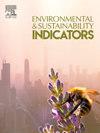The effect of irrigation practices on stress-related physiological characteristics, water productivity, and water footprint in rice cultivation
IF 5.4
Q1 ENVIRONMENTAL SCIENCES
引用次数: 0
Abstract
Water plays a critical role in rice cultivation, a major export commodity in Thailand, especially under climate-induced drought conditions. This study evaluated the impact of three irrigation practices—continuous flooding (CF), alternate wetting and drying (AWD), and saturated soil irrigation (SSI)—on physiological parameters and water usage in paddy fields. The results showed no significant differences in physiological traits such as stomatal conductance (gsw), leaf temperature (Tleaf), chlorophyll fluorescence (Fs), quantum yield (ΦPsII), osmolality, and MDA content. However, water consumption differed notably: in the first crop season, CF, SSI, and AWD used 9,931, 7,106, and 7338 m3/ha, respectively, while in the second season, usage was 9,427, 5,746, and 5794 m3/ha. Grain yield remained similar across treatments: 4.13, 4.03, and 4.08 tons/ha in the first crop season, and 4.21, 4.23, and 4.66 tons/ha in the second crop season for CF, SSI, and AWD, respectively. Water productivity (WPIR) for CF, SSI, and AWD was 0.42, 0.57, and 0.56 kg m−3 in the first crop season and 0.45, 0.74, and 0.80 kg m−3 in the second crop season. The consumptive water footprint (WFconsumption) also varied, with values of 2,607, 1,976, and 2007 m3/ton in the first crop season and 2,431, 1,549, and 1401 m3/ton in the second crop season, with the highest in the direct blue water footprint category. AWD and SSI significantly increased water productivity. The study underscores the potential of physiological data as a tool to inform sustainable on-farm irrigation strategies. The integration of such practices could contribute to climate-resilient and resource-efficient rice production systems.

灌溉方式对水稻种植中与胁迫相关的生理特性、水分生产力和水足迹的影响
水稻是泰国的主要出口商品,水在水稻种植中发挥着关键作用,特别是在气候引起的干旱条件下。本研究评估了连续淹水(CF)、干湿交替灌溉(AWD)和饱和土壤灌溉(SSI)三种灌溉方式对稻田生理参数和水分利用的影响。结果表明,气孔导度(gsw)、叶温(leaf)、叶绿素荧光(Fs)、量子产率(ΦPsII)、渗透压和丙二醛(MDA)含量等生理性状无显著差异。但耗水量差异显著,第一季CF、SSI和AWD的耗水量分别为9,931、7,106和7338 m3/ha,第二季为9,427、5,746和5794 m3/ha。不同处理的籽粒产量基本一致,第一季为4.13、4.03和4.08吨/公顷,第二季为4.21、4.23和4.66吨/公顷。第一季CF、SSI和AWD的水分生产力(WPIR)分别为0.42、0.57和0.56 kg m−3,第二季为0.45、0.74和0.80 kg m−3。消费水足迹(WFconsumption)也各不相同,第一季分别为2,607、1,976和2007 m3/t,第二季分别为2,431、1,549和1401 m3/t,其中直接蓝水足迹最高。AWD和SSI显著提高了水分生产力。这项研究强调了生理数据作为一种工具的潜力,可以为可持续的农田灌溉策略提供信息。这些做法的整合可能有助于建立具有气候适应性和资源节约型的水稻生产系统。
本文章由计算机程序翻译,如有差异,请以英文原文为准。
求助全文
约1分钟内获得全文
求助全文
来源期刊

Environmental and Sustainability Indicators
Environmental Science-Environmental Science (miscellaneous)
CiteScore
7.80
自引率
2.30%
发文量
49
审稿时长
57 days
 求助内容:
求助内容: 应助结果提醒方式:
应助结果提醒方式:


